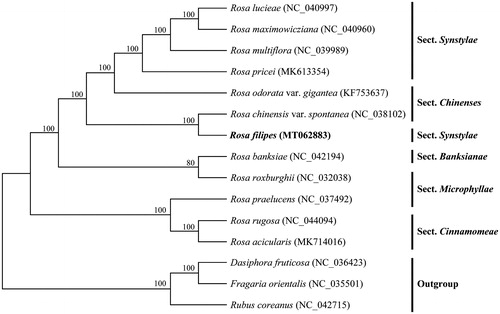Abstract
To understand the genetic background of Rosa filipes, its complete chloroplast genome was determined in this study. The chloroplast genome of R. filipes is 156,624 bp in length with a large single-copy region (LSC) of 85,754 bp, a small single-copy region (SSC) of 18,784 bp, and a pair inverted repeats (IRs) of 26,043 bp. The GC content is 37.2%. A total of 137 genes were identified, including 90 protein-coding genes, 37 tRNA genes, and 8 rRNA genes. Phylogenetic analysis indicated that R. filipes is closely related to R. chinensis var. spontanea.
Rosa filipes Rehder & Wilson (Citation1915), which belongs to R. section Synstylae DC., is a shrub characterized by large compound corymb or panicle inflorescence and glandular-pubescent stipules, rachis, and petiole. It is endemic to southwest and northwest China at an altitude of 1300–2300 m (Yü et al. Citation1985). In this study, we reported the chloroplast genome sequence of R. filipes, and assessed its phylogenetic position within the genus Rosa L.
Total genomic DNA was extracted from silica-dried leaves collected from Baoxing, Sichuan, China (102°45′01.35″E, 30°40′50.95″N, Voucher No. ZZM1250-1, deposited at School of Ecology and Environmental Science, Yunnan University), using a modified CTAB method (Doyle and Doyle Citation1987). Genome sequencing was performed using Illumina Nova Seq 6000 platform at Annoroad Gene Technology (Beijing, China). The clean reads were assembled using NOVOPlasty (Dierckxsens et al. Citation2017) and modified by Geneious Prime v2020.0.4 (https://www.geneious.com). Then, the initial annotation was performed using PGA (Qu et al. Citation2019) and reconfirmed by Geneious Prime v2020.0.4 based on the annotation of R. praelucens Bijh. (NC_037492) and R. multiflora Thunb. (NC_039989). The final complete plastomes were deposited in GenBank with an accession number MT062883.
The full length of R. filipes chloroplast genome is 156,624 bp with a large single-copy region (LSC with 85,754 bp), a short single-copy region (SSC with 18,784 bp) and two inverted repeat regions (IRs with 26,043 bp each). Total GC content is 37.2%. A total of 137 genes were identified and annotated, including 90 protein-coding genes, 37 tRNA genes, and 8 rRNA genes.
To determine the phylogenetic position of newly sequenced R. filipes, phylogenetic analysis was conducted along with 11 representative Rosa species and three outgroup taxa. Fifteen complete chloroplast genome sequences were aligned using MAFFT v7.3 (Katoh and Standley Citation2013). We constructed a phylogeny under the GTR + G model and 1000 bootstrap replicates employing the maximum likelihood (ML) inference in RAxML v.8.2.10 (Alexandros Citation2014). The results showed that R. filipes is closely related to R. chinensis var. spontanea which belongs to R. sect. Chinenses DC. ex Ser. (). The chloroplast genome of R. filipes will provide valuable information for genetic studies of R. sect. Synstylae and Chinenses as well as evolutionary studies of the whole genus.
Disclosure statement
No potential conflict of interest was reported by the author(s).
Additional information
Funding
References
- Alexandros S. 2014. RAxML version 8: a tool for phylogenetic analysis and post-analysis of large phylogenies. Bioinformatics. 30:1312–1313.
- Dierckxsens N, Mardulyn P, Smits G. 2017. NOVOPlasty: de novo assembly of organelle genomes from whole genome data. Nucleic Acids Res. 45(4):e18.
- Doyle JJ, Doyle JL. 1987. A rapid DNA isolation procedure for small quantities of fresh leaf tissue. Phytochem Bull. 19:11–15.
- Katoh K, Standley DM. 2013. MAFFT multiple sequence alignment software version 7: improvements in performance and usability. Mol Biol Evol. 30(4):772–780.
- Qu XJ, Moore MJ, Li DZ, Yi TS. 2019. PGA: a software package for rapid, accurate, and flexible batch annotation of plastomes. Plant Method. 15(1):50.
- Rehder A, Wilson EH. 1915. Rosaceae subfam. Rosoideae. In: Wilson EH, editor. Plantae Wilsonianae: an enumeration of the woody plants collected in western China for the Arnold arboretum of Harvard University during the years 1907, 1908, and 1910. Vol. 2.Cambridge: The University Press; p. 311–312.
- Yü TT, Lu L-T, Ku T-C, Li CL. Kuan K-C ,Chiang W-F. 1985. Rosaceae (2). In: Yü TT, editor. Flora Reipublicae Popularis Sinicae. Vol. 37. Beijing: Science Press; p. 1–516.

